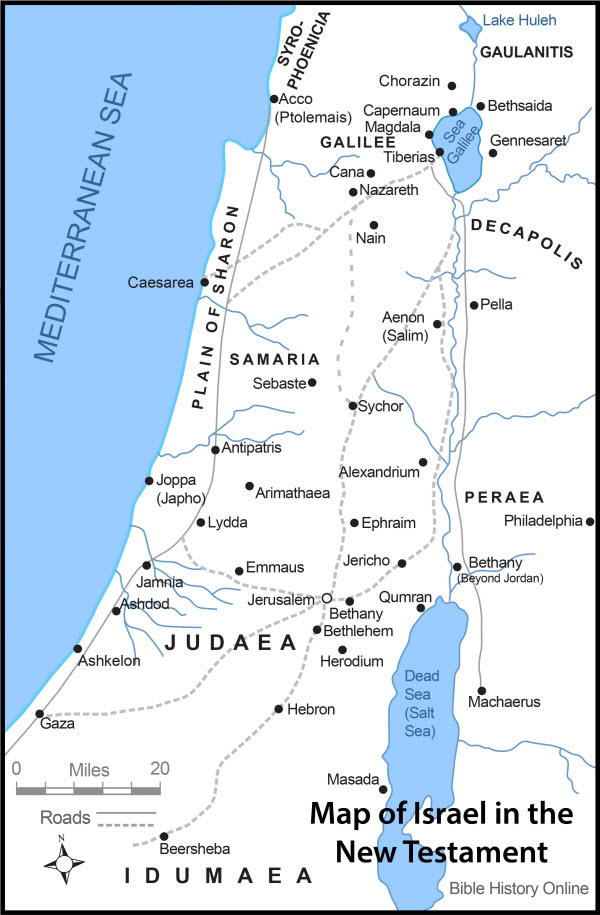 Like many other Christmas carols, the words to “I Saw Three Ships” don’t make much sense when you look closely at them. Had you ever asked yourself the question in the title? Probably not. Most of us don’t carry around a map of Palestine in our heads, so the absurdities of the lyrics aren’t obvious. I’m therefore including such a map below this post, which will serve to prove that indeed it would be impossible for the words of this carol to have any connection to reality at all. So what on earth are the words talking about?
Like many other Christmas carols, the words to “I Saw Three Ships” don’t make much sense when you look closely at them. Had you ever asked yourself the question in the title? Probably not. Most of us don’t carry around a map of Palestine in our heads, so the absurdities of the lyrics aren’t obvious. I’m therefore including such a map below this post, which will serve to prove that indeed it would be impossible for the words of this carol to have any connection to reality at all. So what on earth are the words talking about?
Bear with me here. I’ve taken quite a journey in digging out the meaning of this carol. The happy, bouncy tune and the joyful words actually have a rather grisly background, specifically that of relics. You know, like, bones. Of dead people. Also other items connected with the Christian faith, notably anything to do with the life and death of Christ. Thus (supposed) pieces of the true cross and nails from the Crucifixion have been very popular. But where did this whole relics thing begin? I wondered. Well, it goes back a long way, to the reign of Constantine, the Emperor of Rome who converted to Christianity in 313. How genuine this conversion was, and what actually brought it to pass, are fascinating questions, but for my purposes here I will simply say that whatever his motivation the adoption of this new faith was very advantageous for him. Tradition says that his mother, Helena, was a Christian and taught him about the faith. Here’s a good summing up:
You may recall that the Emperor Constantine, when he converted to Christianity, dispatched his mother to the Holy Land to find evidence of his new religion and bring back its symbols. This she did with a diligent effort, returning with the true cross and a number of other things she located via divine inspiration, and with the assistance of the locals–in the classic fashion, probably taking advantage of a wealthy tourist by showing her all the sights and convincing her to bring home some impressive souvenirs. (from “The Bones of the Magi” on the blog of historical fiction author E. C. Ambrose.)
Doesn’t it seem strange to you that the savvy and resourceful Constantine would be so gullible as to think that his mother wouldn’t be taken advantage of by unscrupulous bone-sellers? Maybe he didn’t care and just wanted some window dressing. Maybe his mom had an itch for traveling. Who knows? But she came home with, indeed, some “impressive souvenirs,” including the true cross, and also the bones of the Wise Men, the Magi, who came to worship the Christ Child. But we’re told specifically in the Gospel of Matthew that “being warned of God in a dream that they should not return to Herod, they departed into their own country another way.” (2:12 KJV) So whoever’s bones they were, we can safely assume they weren’t as advertised. Constantine ended up donating the bones to the Bishop of Milan in 344, where they stayed until 1184 when they were stolen by the Holy Roman Emperor, taken to Cologne, Germany, and enshrined in the great cathedral there. The jeweled caskets that supposedly contain their bones are still in place, “the splendor of whose final voyage has remained vivid in European folk memory.” (The New Oxford Book of Carols) The original version (or at least an original version) of this song is sung by the boatmen delivering the caskets up the Rhine River, who talk about the “three crawns” (skulls) that were taken from Milan to Cologne. You can see the similarity of “crawns” to “crowns,” and indeed three gold crowns were given to the cathedral to be added to the shrine at the end of the 12th century.
Are there any actual bones in the caskets? Why yes. Thank you for asking. When the shrine was opened in 1864, we are told:
In a special compartment of the shrine now there showed – along with remains of ancient old rotten or moulded bandages, most likely byssus, besides pieces of aromatic resins and similar substances – numerous bones of three persons, which under the guidance of several present experts could be assembled into nearly complete bodies: the one in his early youth, the second in his early manhood, the third was rather aged. . . . The bones were wrapped in white silk and returned to the shrine. (Wikipedia)
So how did we get from three caskets full of old bones (whosever they were) to three sailing ships carrying Mary and Jesus? Well, I guess skeletons were a pretty gruesome topic, and so the song changed over time into a more pleasant version. You have to keep in mind that this carol is a true folk song and therefore has many variants. The literal ships that carried the three caskets to Cologne morphed into ones carrying the Holy Family, usually into Bethlehem but sometimes just “sailing by.” Some versions of the carol have Joseph and some have St. John and St. Michael in charge of steering the ship. They all include Mary and Jesus.
I’ve probably tried your patience, dear readers, so I’ll quit there. But if your appetite for the minutia of folk-song evolution has not yet been sated, I’d highly recommend this article from the website Hymns and Carols of Christmas: “I Saw Three Ships.”
Here’s the promised map:

Source: BibleHistory.com
Here’s an arrangement of the carol by John Rutter with great extras: a different tune from the traditional, a whistling part, and a performance in Notre Dame de Paris–there won’t be any further religious services there until April 2024 at the very earliest because of the fire in April 2019, so savor this one:
And here’s at least one version of the lyrics:
I saw three ships come sailing in
On Christmas Day, on Christmas Day;
I saw three ships come sailing in
On Christmas Day in the morning.
Pray, wither sailed those ships all three,
On Christmas Day, on Christmas Day;
Pray, wither sailed those ships all three,
On Christmas Day in the morning.
O they sailed into Bethlehem,
On Christmas Day, on Christmas Day;
O they sailed into Bethlehem,
On Christmas Day in the morning.
And all the bells on earth shall ring,
On Christmas Day, on Christmas Day;
And all the bells on earth shall ring,
On Christmas Day in the morning.
And all the souls on earth shall sing,
On Christmas Day, on Christmas Day;
And all the souls on earth shall sing,
On Christmas Day in the morning.
Then let us all rejoice again,
On Christmas Day, on Christmas Day;
Then let us all rejoice again,
On Christmas Day in the morning.
I saw three ships come sailing in
On Christmas Day, on Christmas Day;
I saw three ships come sailing in
On Christmas Day in the morning.
I saw three ships come sailing in
On Christmas Day, on Christmas Day;
I saw three ships come sailing in
On Christmas Day in the morning.
©Debi Simons

